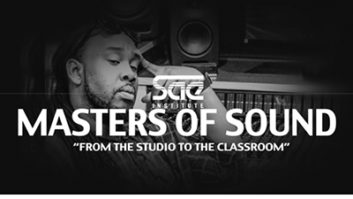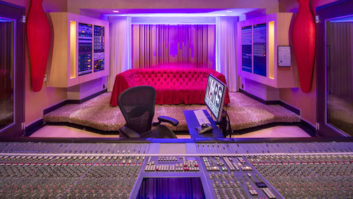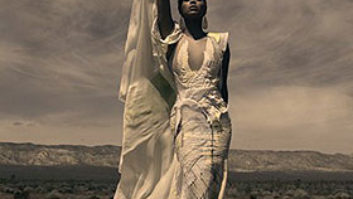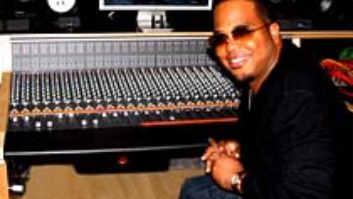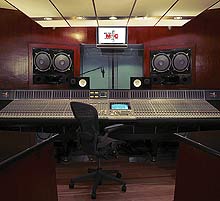

Bearing the trademark prefix of hip hop impresario Jay-Z’s Roc-a-Fella Records, the brand-new Roc the Mic Studios in New York City caters to the label’s extended family of artists, producers, engineers and songwriters who make hip hop and R&B music. This is the second studio venture for Jay-Z’s longtime business collaborator, Juan Perez; they also own Manhattan’s 40/40 Club. Perez sold their previous facility — Baseline Studios — to Roc-a-Fella producer alum Just Blaze when Jay-Z put his solo career on hold in 2003. But, as Jay-Z returned with Kingdom Come last year, plans for a bigger and better studio were already well under way.
The A room with SSL 9000 J board, home to engineer Brian Stanley.
Photo: Wes Bender/Mojo working int. 2007
Perez found a totally raw space on 27th Street and got in touch with Professional Audio Design president Dave Malekpour, who had set up Baseline. “With Roc-a-Fella’s roster of artists and all the production development going on, it made total sense that they build a studio catering to the label,” says Malekpour. “And Juan decided to make it a commercial studio because of the current market conditions. There aren’t many rooms like this available in New York City anymore.”
Malekpour recommended that frequent PAD-collaborator John Storyk of Walters-Storyk Design Group (WSDG) be brought onto the project as designer and acoustician. “They have their entourage of golden ears and knew exactly what they wanted,” says Storyk. “Two spacious comfortable studios, each with an analog desk, very loud, very accurate monitors and private lounge inside the sound lock. They also wanted a small writing room, which through the design process actually grew into a producer’s suite and booth — a mini version of the main rooms.”
Proportionally, the 4,500-square-foot space splits up visibly to urban music production code: smaller tracking spaces, larger control rooms and sizeable lounges. Clients can shoot pool and hang out in the main common lounge, or keep completely to themselves via private access to both main studios, each with its own similarly sized tracking room and private lounge. Technically, the rooms feature the classic tools of the genre. The only marked difference between the two main studios, known as the “J Room” and “G Room,” is the choice of SSL consoles of heavy-hitting Roc The Mic house engineers Brian Stanley (9000 J) and Young Guru (4000 G+). PAD worked with these engineers to develop the rooms’ equipment lists, a combination of new and PAD-refurbished classic gear, including Avalon 737s; Lexicon 480Ls, PCM 81 and 42s; Distressors; Eventide H3000 and TC Electronic reverbs; and Summit dual-compressors that stack up in split-island producers’ desks.
The J Room houses the 9080 J console from the Hit Factory, completely refurbished with upgraded electronics by PAD. An inaugural session with Beyonce opened J back in January, kicking off nonstop action at Roc the Mic. “Everyone’s been here,” says Perez, running down the list: “Mariah, Puff, Timbaland, Timberlake, Rhianna, 50 Cent, will.i.am, Ne-Yo, Jay-Z.” The J Room and surprise-hit production studio — equipped with Control|24 and Pro Tools HD — have been running full time for several months, and by the end of summer the G+ was undergoing final commissioning.

Roc the Mic engineer Young Guru
Photo: Howard Sherman
The studios are distinguished by their thumping sound systems, a design requirement Perez stressed from the get-go. “This is a hip hop environment; people want to really crank it up to see how it’s gonna knock in the clubs,” he explains. “You’ll have 10 guys in here bopping their heads. This is the culture; this is how hip hop gets played.”
Developed by PAD and George Augspurger, the custom monitoring systems comprise Augspurger horns, dual 15-inch drivers and dual 18-inch subs per side, driven by massive Bryston 14B power amps. “These are loud and efficient systems; they’re getting about 127dB peaks, continuous at around 123 dB,” says Malekpour. “It’s really a second-to-none main monitoring system, and we scaled it down to fit the smaller footprint in the production suite. So that’s a much smaller room, but it has the big Augspurger sound.”
Storyk’s designs incorporated extreme isolation and bass trapping to accommodate such a big and bass-heavy sound. Working with less-than-ideal ceiling height, Storyk explains, “We did all the low-frequency trapping with thin-membrane absorbers, using both stretched-rubber and metal plate absorbers throughout the room — above the clouds and behind the fabric on either side of the rear-room resonators.”
Guru, who recorded Jay-Z’s verses for Rhianna’s “Umbrella” and T.I.’s “Watch What You Say to Me,” among many other projects in the J Room, attests. “I’m not an exceptionally loud mixer — I’ll mix loud in the beginning to get the drum and bass relationship together and then I’ll move to near-fields — but the clients want to hear it loud,” he explains. “These rooms are clear at those really loud volumes; we love that we can turn it way up and maintain the consistency of the mix.”
Janice Brown is a freelance writer in New York City.

WATCH:
Roc the Mic Schematic

